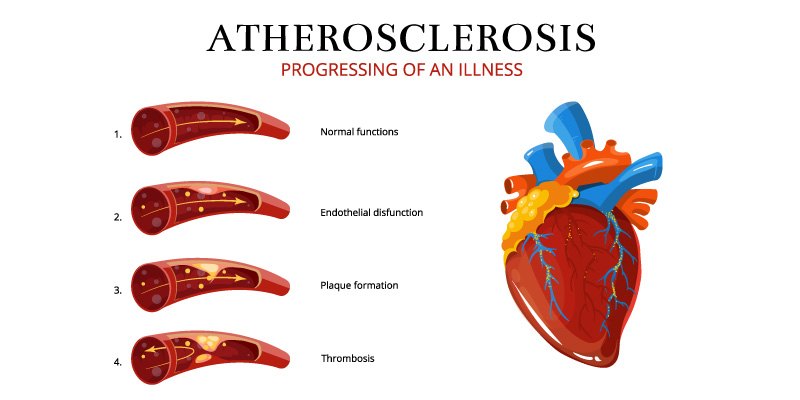Atherosclerosis is a disorder in which the arteries become stiff and thick, reducing blood flow to the tissues and organs, which means plaque is formed inside the arteries. Healthy arteries are generally elastic and flexible, but due to the build-up of plaque, the walls of the arteries are hardened and becomes narrow, which restricts the blood flow.
The plaque can trigger a blood clot. Atherosclerosis can affect any arteries of the body, leading to serious health problems like a heart attack or stroke. Atherosclerosis is also known as Arteriosclerosis and hardening of the arteries.
Some Common Facts about Atherosclerosis
- Atherosclerosis is a disorder that causes the narrowing of the arteries due to the buildup of plaque.
- Enhanced medications have decreased the number of deaths from Atherosclerosis-related diseases. Proper treatment can also improve the quality of life of people with Atherosclerosis disorder.
- Atherosclerosis is also known as arteriosclerosis and hardening of the arteries.
- According to a study, Atherosclerosis accounts for 32% of deaths. 13.8% is amongst adults of 20 years and above.
- Globally, Atherosclerosis is the principal cause of vascular disease. The major clinical signs involve ischemic stroke, ischemic heart disease, and peripheral arterial disease.
Causes of Atherosclerosis

Atherosclerosis is a complex, and progressive disorder, that may initiate in childhood only. The exact reason for Atherosclerosis is not known, but this may begin by an injury or damage to the innermost layer of the artery. The damage may be caused due to:
- High triglycerides
- High blood pressure
- High cholesterol
- Smoking
- Inflammation from diseases
- Insulin resistance
- Obesity
- Diabetes
When the innermost layer of the artery is affected, blood cells and other elements usually clomp at the damaged section and develop in the innermost wall of the artery. With time, the plaque hardens and narrows the arteries. The tissues and organs do not receive sufficient blood to work properly because of the blocked arteries. Eventually, the cholesterol, fat, calcium, and other elements may enter the bloodstream.
Besides, the smooth wall of the plaque may break, spilling cholesterol and other components into the bloodstream. This may lead to the blood clot, blocking the flow of the blood to that particular part of the body. The blocked blood flow to the heart can cause a heart attack.
Risk factors of Atherosclerosis:
The hardening of arteries happens over time. Certain traits and conditions that may enhance the risk of the disease are:
- Obesity
- High cholesterol
- High blood pressure
- Diabetes
- An unhealthy diet
- Smoking
- Tobacco use
- Lack of exercise
- A family history of heart disease
Symptoms of Atherosclerosis

Atherosclerosis usually develops steadily and it does not have any signs or symptoms, till the time severely blocks or narrows an artery. However, some of the common symptoms are:
- Shortness of breath
- Angina or chest pain
- Fatigue
- Pain in legs, arms, or anywhere else that has a blocked artery
- Muscle weakness in the legs
- Confusion occurs if the blockage affects circulation to the brain
A blood clot can block the flow of blood or can even trigger a stroke or a heart attack.
Common symptoms of heart attack are:
- Abdominal pain
- Chest pain or discomfort
- Shortness of breath
- Pain in the back, shoulders, arms, neck, and jaw
- Perspiration
- Nausea or vomiting
- Lightheadedness
- A sense of impending doom
Common symptoms of a stroke are:
- Trouble in speaking
- Trouble in understanding speech
- Weakness or numbness in the face or limbs
- Severe headache
- Loss of balance
- Vision problems
The signs and symptoms of Atherosclerosis depend on arteries that are affected:
If Atherosclerosis is in the Coronary Arteries, then the common symptom is:
- Angina
- Chest pain
- Shortness of breath
- Sleeping problem
- Fatigue
- Lack of energy
If renal arteries are affected by plaque then chronic kidney disease may develop:
- Chronic kidney disease
- Tiredness
- Loss of appetite,
- Nausea
- Swelling in the hands or feet
- Itchiness or numbness
- Trouble concentrating
If peripheral arteries are affected, then the person will experience:
- Pain in the leg while walking
- Numbness
- Sometimes dangerous infections
If the plaque blocks or narrows the carotid arteries, then the symptom is of stroke, which includes:
- Paralysis or numbness of arms, legs, or face
- Sudden weakness
- Confusion
- Problem in breathing
- Loss of consciousness
- Dizziness
- Trouble in speaking or understanding speech
- Sudden and severe headache
Diagnosis of Atherosclerosis

Depending on the condition, the doctor suggests one or more tests to diagnose Atherosclerosis. These tests help the doctor to understand the condition and plan the best treatment.
Blood Tests
Blood tests can detect the levels of cholesterol, fats, sugar, and proteins in the blood, and abnormal levels may enhance the risk of Atherosclerosis.
ECG (Electrocardiogram)
An electrocardiogram is a painless test that records electrical signals as they move through the heart. The test records the heartbeat and its rhythm, constant or irregular. An ECG can also show signs of a previous heart attack and damage caused by CHD.
Stress Testing
A stress test is also known as an exercise stress test, practiced for finding information about how the heart works during physical activity. The exercise stress test can show the problems in the heart that might not be detectable otherwise.
An exercise stress test can determine the probable signs and symptoms of CHD, like:
- Unusual changes in the heart rate or blood pressure
- Shortness of breath
- Chest pain
- Unusual changes in the heart rhythm or the heart’s electrical activity
Angiography
In Angiography, special x rays and dye are used to show the inside of the arteries. This test determines the blockage in the arteries due to plaque.
Doppler Ultrasound
The doctor may employ a special ultrasound device known as Doppler ultrasound, to regulate the blood pressure at different points accompanying the arm or leg. The measurements help the doctor to check the degree of any blockages, along with the rate of blood flow in the arteries.
Conclusion
Atherosclerosis is a condition in which plaque is formed inside the arteries and restricts the blood flow to the tissues and organs. However, always consult doctors as Atherosclerosis can affect any arteries of the body, leading to serious health problems like a heart attack or stroke.




